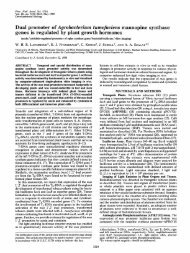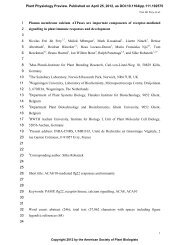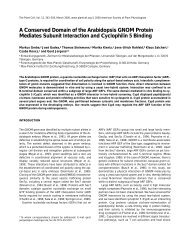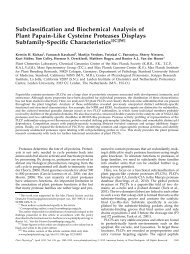1 Transposon and T-DNA mutagenesis
1 Transposon and T-DNA mutagenesis
1 Transposon and T-DNA mutagenesis
You also want an ePaper? Increase the reach of your titles
YUMPU automatically turns print PDFs into web optimized ePapers that Google loves.
Protocol 1. Continued<br />
2. Follow segregation of the phenotype in the progeny <strong>and</strong> screen for<br />
presence of the transposase locus (e.g. by selecting for antibiotic<br />
resistance) (see Chapter 1 for growing Arabidopsis under selective<br />
conditions). If the mutant contains the transposase locus, screen<br />
100-1000 progeny for wild-type looking revertants to test the stability<br />
of the mutant phenotype.<br />
3. If the mutant does not contain a transposase locus, screen siblings to<br />
find a family expressing transposase. When found, screen the progeny<br />
as in step 2. Alternatively screen the F, from cross 2 for families with<br />
transposase. When found, screen progeny as in step 2. Only proceed<br />
when revertants are found.<br />
4. Identify a transposon insertion co-segregating with the mutation.<br />
Preferably use a population without transposase (e.g. F2 from cross I),<br />
segregating 3:l for wild-type:mutant. Alternatively, use a population<br />
with transposase, such as the F2 from cross 2, or revertant <strong>and</strong> mutant<br />
progeny of the original mutant when the mutant contained the transposase<br />
locus. Perform a Southern blot analysis on about 50 plants for<br />
an I element tagged mutant (multiple inserts), or on about 10 plants<br />
(half mutant, half wild-type revertant) for a Ds tagged mutant (single<br />
or a few inserts). Load equal amounts of <strong>DNA</strong> per lane to distinguish<br />
between homozygous <strong>and</strong> hemizygous inserts. Make use of other<br />
populations if no co-segregating transposon can be identified.<br />
5. Isolate genomic <strong>DNA</strong> flanking the co-segregating transposable element<br />
by IPCR (Protocol 2) using preferably <strong>DNA</strong> template from a plant<br />
lacking the transposase locus <strong>and</strong> carrying less than five copies of<br />
transposon inserts (especially for I element-induced mutants). If no<br />
plants with less than five inserts was found, use a backcross of the<br />
mutant with wild-type (F, cross 1 x wild-type). to reduce the<br />
transposon copy number.<br />
6. Confirm the cloning of genomic <strong>DNA</strong> flanking the transposon by:<br />
(a) Hybridizing the IPCR probe to a Southern blot containing <strong>DNA</strong><br />
from mutant <strong>and</strong> revertant plants, to reveal homozygous inserts in<br />
mutant <strong>and</strong> hemizygous or no inserts in revertant plants.<br />
(b) Analysis of the insertion site. Determine the sequence of <strong>DNA</strong><br />
fragments carrying genomic <strong>DNA</strong> flanking the transposon insert<br />
using the IPCR fragments as template. Design PCR primers for the<br />
amplification of the insertional target site from wild-type <strong>DNA</strong>.<br />
PCR amplify the target site sequences from wild-type, revertant,<br />
<strong>and</strong> mutant alleles without inserts. Clone the PCR products <strong>and</strong><br />
determine their <strong>DNA</strong> sequence. All revertants should have at least<br />
one allele with (near) wild-type <strong>DNA</strong> sequence. All mutants should<br />
have only alleles featuring frameshifts, aberrant termination, or<br />
amino acid exchanges.<br />
7. Isolate genomic <strong>and</strong> c<strong>DNA</strong> clones from appropriate A phage libraries<br />
using the IPCR products as probes, <strong>and</strong> determine their <strong>DNA</strong> sequence.<br />
Homozygous mutant plants may not always contain a transposon insert in<br />
both mutant alleles. Occasionally, one of the inserts may transpose <strong>and</strong> leave<br />
an excision footprint behind, thus generating a stable mutant allele. When<br />
transposon insertions occur in coding regions, this is rather a rule than<br />
exception. Upon insertion, both Ds <strong>and</strong> I element generate a target site<br />
duplication of 8 bp <strong>and</strong> 3 bp respectively. Excision of these elements often<br />
deletes or duplicates a few base pairs leading to a frameshift or gen'erating a<br />
stop codon. An adequate proof for cloning the correct gene can therefore be<br />
obtained by correlating the sequence of excision alleles with the plant<br />
phenotype. Revertant plants should have at least one allele for encoding a<br />
wild-type-like protein, whereas both alleles of a mutant should display an<br />
aberrant reading frame.<br />
0<br />
I 1<br />
Protocol 2.<br />
Equipment <strong>and</strong> reagents<br />
Isolation of <strong>DNA</strong> probes flanking /element inserts in<br />
Arabidopsis thaliana by IPCR<br />
Eppendorf tubes<br />
Liauid nitroaen<br />
1 ~obendorf-;ha~ed . . . arinders -<br />
14'C, 37°C. 65'C incubator<br />
Thermocycler<br />
<strong>DNA</strong> extraction buffer: 0.3 M NaCI, 50 mM<br />
~~i~ p~ 7.5, z0 m~ EDTA, 2% ( ,I<br />
. TE: 10 mM Tris-HCI, 1 mM EDTA pH 8<br />
. DNase-free RNase A (10 mg/ml stock)<br />
. Enzymes: Hinfl, <strong>DNA</strong> polymerase I Klenow I<br />
fragment, Sail<br />
Spermidine (Sigma): prepare a 100 mM<br />
stock, store at -20°C<br />
2.5 mM dNTPs (2.5 mM each dNTP)<br />
sarkosyl, 0.5% (w/v) SDS, 5 M urea, 5% (vk) 0.3 sodium acetate pH 5.5<br />
phenol (eguilibrated) (52); the first five T4 <strong>DNA</strong> ligase<br />
ingredients' are mixed as a 2 X stock<br />
0.45 M NaCl<br />
solution, <strong>and</strong> urea <strong>and</strong> phenol are added . T , <strong>DNA</strong> ~ polymerase<br />
before use<br />
10 x PCR buffer<br />
Phenol (saturated):chloroform (1:1)<br />
10 x TBE: 108 g Tris base, 55 g boric acid,<br />
100%. 70% (vh) ethanol 9.3 g Na,EDTA per litre<br />
lsopropanol<br />
1.2% (wh) agarose (electrophoresis grade)<br />
Primers:<br />
in 0.5 X TBE<br />
1st PCR lLJl (120 ng/~I) GAA TIT AGG GAT CCA 7TC ATA AGA GTG T<br />
lRJl(120 ng/pl) lTG TGT CGA CAT GGA GGC TTC CCA TCC GGG GA<br />
2nd PCR lLJ2 (120 nylpl) A T AAA AGC CTC GAG TTC ATC GGG A<br />
IRJ2 (120 ng/pl) AGG TAG TCG ACT GAT GTG CGC GC<br />
3rd PCR ITlR (105 ng/kl) GAC ACT CCT TAG ATC TtT TCT TGT AGT G<br />
A. lsolation of <strong>DNA</strong> from a single plant (52ja (especially for I elements)<br />
1. Harvest 100-150 mg of leaf or preferably inflorescence tissue per plant<br />
in an Eppendorf tube. Freeze in liquid N2.






